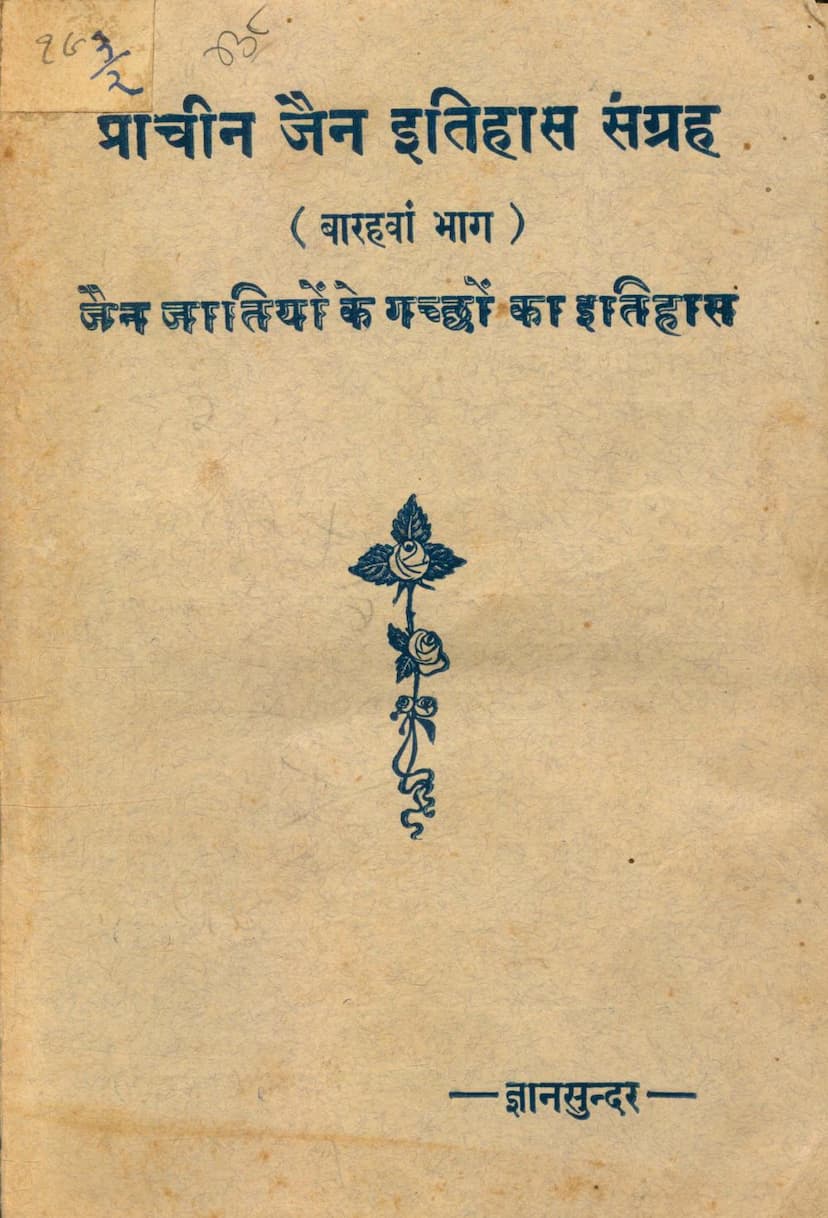Jain Jatiyo Ke Gaccho Ka Itihas Part 01
Added to library: September 2, 2025

Summary
Here's a comprehensive summary of the Jain text "Jain Jatiyo ke Gaccho Ka Itihas Part 01" (History of Jain Sects/Communities, Part 1) by Gyansundar, published by Ratnaprabhakar Gyan Pushpamala:
This book is a historical exploration of the origins and evolution of various Jain communities and their associated gacchas (monastic lineages or groups). The author, Muni Gyansundar, aims to trace the lineage of these communities back to their foundational figures and understand their historical development.
Key Themes and Content:
-
The Mahajan Sangh and Upkeshpur:
- The book establishes that the Mahajan Sangh (a community primarily of merchants) originated in Upkeshpur (identified as the modern-day Osiyan) about 70 years after the Nirvana of Lord Mahavir (approximately 400 BCE).
- It asserts that "Mahajan Sangh," "Upkeshvanesh," and "Oswal" are synonymous terms for this community.
- A significant event mentioned is a disruption at Upkeshpur around 373 years after Lord Mahavir's Nirvana, involving damage to a statue of Lord Mahavir. This event led some Jain followers to leave Upkeshpur, and they became known as "Upkeshi," later evolving into "Upkeshvanesh."
-
The Etymology and Evolution of Names:
- The text explains that the names Uesh, Ukesh, and Upkesh all refer to the city of Upkeshpur.
- Similarly, Ueshvanesh, Ukeshvanesh, and Upkeshvanesh refer to the community or lineage.
- And Ueshgaccha, Ukeshgaccha, and Upkeshgaccha refer to the monastic lineage associated with this community.
- The transformation of Upkeshpur to Osian and Upkeshvanesh to Oswal is attributed to linguistic evolution over time, particularly around the 11th century CE.
-
The Origins of the Oswal Community:
- The book emphasizes that the founder of the Oswal community was Acharya Ratnaprabh Suri.
- It argues that the Upkeshgaccha was the primary gaccha that nurtured and guided the Oswal community for approximately 1500 years after Acharya Ratnaprabh Suri.
-
The Establishment of Major Jain Communities:
- The book identifies three main and ancient Jain communities:
- Shrimali
- Pragvat (also known as Porwal)
- Upkesh Jati (Oswal)
- It states that Acharya Swayamprabh Suri (a disciple of Acharya Keshi Shraman) was the founder of the Shrimali and Porwal communities. He was also the guru of Acharya Ratnaprabh Suri.
- The book asserts that the Upkeshgaccha is the original gaccha for both Shrimali and Porwal communities, as they were nurtured by its lineage of acharyas.
- The book identifies three main and ancient Jain communities:
-
The Development of Gacchas:
- The text details the proliferation of gacchas over centuries. It mentions the emergence of new gacchas due to variations in Jain practices after about 1500 years of the Upkeshgaccha's influence.
- It lists and describes various gacchas and the communities associated with them, including:
- Korant Gaccha (a branch of Upkeshgaccha, founded by Acharya Kanakprabh Suri)
- Nagpuria Tapagaccha
- Brihad Tapagaccha
- Anchal Gaccha
- Malladhar Gaccha
- Purnamiyagaccha
- Nanawal Gaccha
- Surana Gaccha
- Palliwal Gaccha
- Kandarsa Gaccha
- Santhera Gaccha
- Khartargaccha (discussed extensively in later sections)
-
The 18 Gotras of the Mahajan Sangh:
- The book meticulously lists 18 primary gotras (clans) of the Mahajan Sangh that emerged from the Mahad-snatra (a major ritualistic bath ceremony) in Upkeshpur. These include:
- Taptabhatta (Tated)
- Bappnaga (Wafana)
- Karnat (Karnawat)
- Balaha (Rankawat, Vankawat)
- Shri Shrimall
- Kulhat (Surwa)
- Virahat (Bhurant)
- Shreshthi (Vaidya Mehta)
- Suchinti (Sancheti)
- Adityanaga (Choradia)
- Bhoori (Bhatewara)
- Bhadra (Samdariya)
- Chinchata (Desarda)
- Kumbhata
- Dido (Kochhar Mehta)
- Kanojiyā
- Laghu Shreshthi
- Mandovara (and others like Charad, Sughad, Lung, Gattiya)
- The author then details the numerous sub-branches (shakha) of these 18 primary gotras, totaling 526 identified branches.
- The book meticulously lists 18 primary gotras (clans) of the Mahajan Sangh that emerged from the Mahad-snatra (a major ritualistic bath ceremony) in Upkeshpur. These include:
-
Critique of the Khartargaccha:
- A significant portion of the book is dedicated to debunking the claims made by the Khartargaccha, particularly regarding the origin of various Oswal gotras and communities.
- The author strongly refutes the Khartargaccha's assertion that they founded many prominent gotras like Choradia, Bafana, Sancheti, and Ranka.
- He provides extensive evidence from inscriptions, historical texts, and pattavalis to show that these communities and their gotras existed centuries before the establishment of the Khartargaccha (founded by Acharya Jintdat Suri in the 12th century CE).
- The book argues that the Khartargaccha's claims are based on fabricated stories and misinterpretations of history, aimed at increasing their own influence.
- It highlights instances where Khartargaccha acharyas allegedly manipulated rituals or family events to claim allegiance from existing communities.
- The author emphasizes that the true lineage and founders of these communities are rooted in the Upkeshgaccha and its associated acharyas, particularly Acharya Ratnaprabh Suri.
- The book cites legal judgments (like the one from the Jodhpur court) that confirm the Upkeshgaccha lineage of certain communities, such as the Choradiyas.
-
Evidence and Methodology:
- The author relies heavily on ancient Jain inscriptions, historical manuscripts, pattavalis (lineages of spiritual successors), and scholarly works by historians like Munshi Devi Prasad and Babu Purnachandra Nahar.
- He uses a critical approach to analyze historical claims, especially those made by the Khartargaccha, comparing them against foundational Jain texts and epigraphical evidence.
Overall Purpose:
The book serves as a historical defense of the origins and traditions of the Mahajan Sangh, specifically the Oswal community and their associated gacchas, against what the author perceives as revisionist claims by the Khartargaccha. It aims to establish the ancient roots of these communities within the framework of the Upkeshgaccha and the teachings of earlier acharyas like Ratnaprabh Suri. The work is a testament to the author's dedication to preserving Jain history and correcting perceived historical inaccuracies.